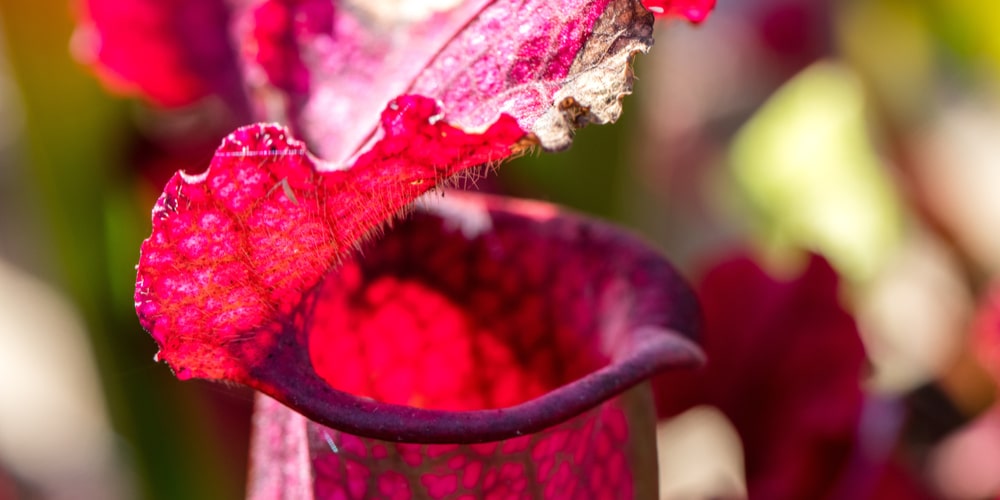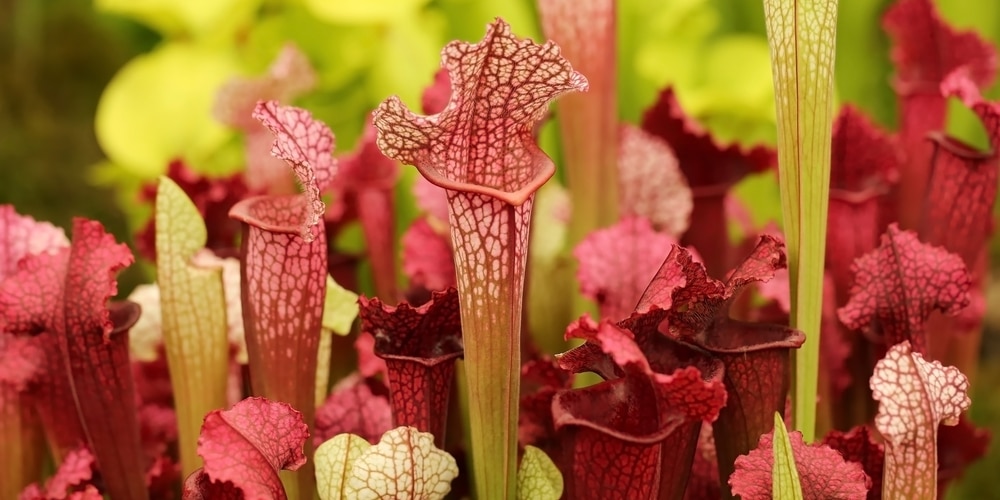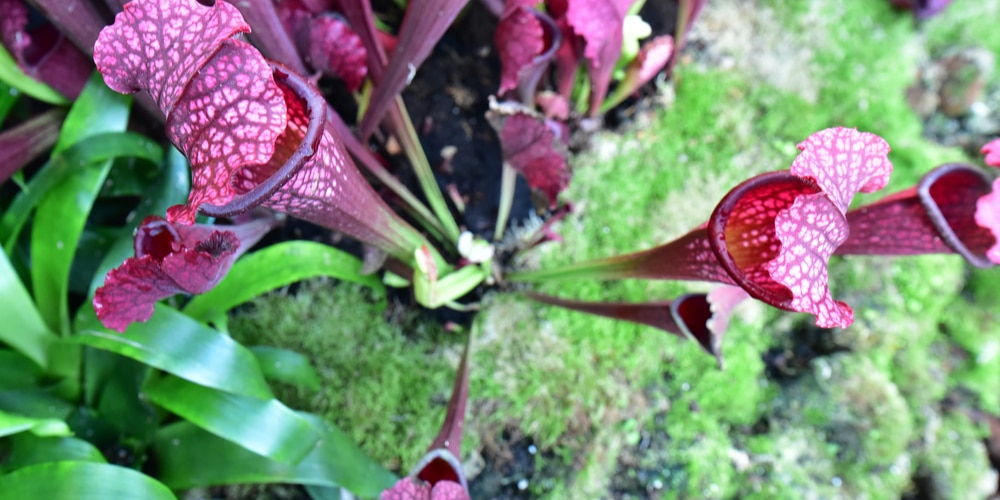Sarracenia juthatip soper, also known as the pitcher plant, is a carnivorous plant native to North America. With its unique appearance and appetite for insects, it has become a favorite among indoor gardeners. While it is not difficult to care for a pitcher plant, there are a few things you should know before getting started.
Pitcher plants are typically found in nutrient-poor environments such as bogs and swamps. As a result, they have evolved to be able to capture and digest insects and other small animals to obtain the nutrients they need.
The pitchers themselves are modified leaves that have evolved to trap and drown prey. Once an insect or other animal falls into a pitcher, it is unable to escape and will eventually be digested by the plant.
| Botanical Name | Sarracenia Juthatip Soper |
| Common Name | Pitcher plant |
| Plant Type | Perennial |
| Flower Color | Showy flowers in shades of cream and russet |
| Size When Mature | 6-12 inches |
| Bloom Time | Late spring to early summer |
| Sun Requirements | Full sun to partial shade |
| USDA Hardiness Zones | 5-9 |
| Soil PH Range | 4.5 – 5.0 |
| Soil Type | Acidic, moist, well-draining |
| Water Needs | High |
| Native Area | North America |
What You Need to Know About Sarracenia Juthatip Soper
Sarracenia juthatip soper got its name from its distinctive shape. This plant features a long, slender stem with a large “pitcher” at the end. The pitcher is usually green but can also be red or yellow, taking on different shades as the plant matures. The inside of the pitcher is lined with downward-facing hairs that prevent prey from escaping.
The plant is highly attractive not just to people but also to insects attracted to the nectar found at the bottom of the pitcher. Once they fall in, they are unable to escape and will eventually be digested. With its ability to survive and do well even in poor soil conditions, Sarracenia juthatip soper is an excellent plant for beginner gardeners.
Pitcher plants are best suited for growing in pots or other containers. This allows you to control the amount of water and nutrients they receive, making it easier to bring them indoors if necessary. With its beautiful flowers blooming in the summer, Sarracenia juthatip soper is sure to be a wonderful addition both to your indoor and outdoor garden!
How to Care for Sarracenia Juthatip Soper
Here’s everything you need to know about growing and caring for a thriving Sarracenia juthatip soper or pitcher plant.
Light
The pitcher plant (Sarracenia juthatip soper) is a beautiful and unusual plant that is native to North America. Because of its unique appearance, it is highly sought after by gardeners and hobbyists alike. An even better reason to grow this plant is that it is very easy to care for!
Pitcher plants need a bright spot with lots of direct sunlight or full sun exposure. While they may tolerate some shade, these plants thrive best and grow larger when exposed to at least 8 hours of full sun. A bit of afternoon shade is always recommended to prevent the leaves from getting scorched.
If you’ve decided to plant your sarracenia juthatip soper indoors, make sure to place it near a south- or west-facing window. This is to ensure that the plant gets enough light all throughout the day. Don’t forget to rotate the plant every so often to prevent it from leaning towards the light source.
Water and Soil Needs
Despite the fact that it can survive even in the worst soil conditions, this plant thrives and produces vibrant leaves and flowers when given the right growing conditions.
Pitcher plants like their soil to be on the acidic side with a pH level of 4.5 to 5.0. You can easily achieve this by adding organic matter such as sphagnum peat moss or compost to your planting area. If you’re potting your plant, make sure to use a potting mix that’s specifically for carnivorous plants.
You should also be watering your pitcher plant regularly, making sure to keep the soil moist but not soggy at all times. While these plants are very hardy and can withstand a lot of neglect, they do need regular watering throughout the growing season (spring through fall).
While the plant thrives in wetter conditions, it can get easily stressed if left in standing water. To ensure that your pitcher plant gets enough water, you should check its soil conditions daily and water as needed.
If you’re growing sarracenia juthatip soper outdoors, make sure to water your plant during the warmer months when it’s actively growing.
Temperature Requirements
Pitcher plants like their growing environment to be warm and humid. Aim for a temperature of at least 75° F (24° C) during the day and no lower than 65° F (18° C) at night. This plant survives in USDA hardiness zones 5 to 9. This plant tolerates a lot of humidity and thrives best in areas with high rainfall levels.
Fertilizer
The best fertilizer to use on sarracenia juthatip soper is a water-soluble, balanced fertilizer high in nitrogen. You should be fertilizing your plant every 2 to 4 weeks during the growing season, from spring through fall. Be sure to dilute the fertilizer to half the recommended strength before applying it to your plant.
However, because of its carnivorous nature, this plant does not require a lot of fertilizer. This is because the plant gets its nutrients from the insects it traps and eats.
Common Diseases
Common infections in pitcher plants include fungal growths and pests such as fungus gnats and mealy bugs. Because these plants are typically grown in humid environments, it’s essential to make sure that the soil is well-drained to prevent any fungal growth.
Fungus gnats are small, black flies that often congregate around the base of the plant. These pests are attracted to the moisture in the soil and can quickly become a nuisance. To get rid of these pests, you can either use a chemical insecticide or a more natural method, such as placing yellow sticky traps around the base of the plant.
Mealybugs are small, white insects that often infest pitcher plants. These pests feed on the plant’s sap, which can quickly weaken and kill the plant.
Mealybugs can be controlled with a number of different methods, including the use of chemical insecticides, horticultural oils, or even soapy water.
Sarracenia Juthatip Soper Propagation
Pitcher plants are fascinating carnivorous plants that exhibit intriguing adaptations for capturing their prey. In addition to their specialized, tubular leaves that act as pitfall traps, these plants also have lid-like leaves designed to prevent rain from diluting their digestive enzymes.
And when it comes to propagation, pitcher plants are just as unique and fascinating. The seeds of these plants typically germinate directly in the soil, though some require an external seedbed for optimal growth. Seed stratification may be needed in order to germinate your pitcher plant seeds.
Once the seedlings begin to emerge, water them regularly and let them grow for about a year before separating or transplanting them. To separate these plants, simply cut through the rhizome with a knife or gardening shears. You can also use a scalpel to remove individual leaves from the rhizome.
When transplanting, make sure to choose a pot that’s large enough to accommodate the plant’s roots. Pitcher plants have relatively shallow root systems, so a standard pot should be sufficient. Be sure to use a well-draining potting mix, as these plants do not like sitting in water.
Sarracenia juthatip soper: Final Thoughts
The pitcher plant, or Sarracenia juthatip soper, is a fascinating species that has captivated scientists and nature enthusiasts alike. Found in wetlands, this unique carnivorous herb uses its specialized leaves to lure unsuspecting prey into its pitcher-like traps.
Unlike other carnivorous plants that rely on insects for nutrients, the pitcher plant obtains most of its nutrients from the decaying organisms trapped inside its tubular leaves.
This allows the pitcher plant to gain additional energy from prey without constantly hunting for new insects.
Caring for a pitcher plant is relatively simple, and with the right conditions, this fascinating plant can grow quite well! Be sure to provide your plant with a well-drained potting mix, plenty of sunlight, and regular waterings.


